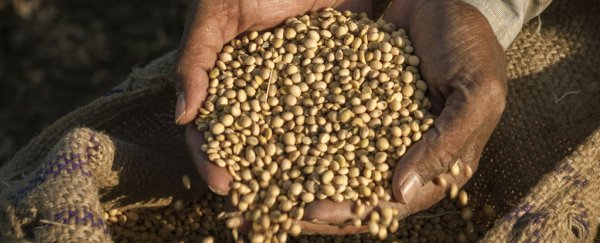Major improvements in global food security over the course of the next decade should see hunger levels drop sharply in developing countries, as people are better able to obtain and afford food, the US Department of Agriculture (USDA) has predicted.
According to new projections, dropping food prices and rising income levels will improve food security in 76 low- and middle-income countries. Right now, 17 percent of the population in developing countries overall don't have adequate access to food, but by 2026, that number should drop to just 6 percent, says the USDA.
That's a pretty staggering decline, reflecting a fall of 59 percent in the overall amount of people who don't have enough to eat. That means we're looking at world hunger dropping from some 609 million people in 2016 to a projected 251 million by the end of the decade.
As the USDA acknowledges, it's important to remember that these projections are based on current world economic conditions, food prices, and incomes – and any number of variables could ultimately change the food security outlook in the near-term future.
But the numbers today certainly offer reasons to feel positive about lowering hunger levels, and one of the most important factors in this is the dropping cost of grains, which account for the bulk of the diet in the 76 developing countries the researchers looked at.
According to the USDA, corn in particular is expected to fall sharply in price, at approximately 1.6 percent per year in inflation-adjusted terms. Wheat and rice prices are also expected to decline, at annual rates of 1.3 percent and 0.3 percent respectively.
The USDA bases its numbers on a nutritional target of 2,100 calories per person per day. Basically, with rising incomes and lowering food prices, more people in more countries are hitting this target, which sees them classified as food secure, rather than food insecure.
In terms of regions making the biggest progress, Asia leads the pack, with the share of the population that is food insecure projected to decline from 13.2 to 2.4 percent by 2026. This is driven by improving conditions in India, which is enjoying cheaper food prices and high per capita income growth of nearly 7 percent per year.
Food security in Latin America and the Caribbean is also projected to improve, although the outlook in Sub-Saharan Africa – which accounts for 45 percent of food insecure peoples in countries the study looked at – is less hopeful, with slower growth expected.
The USDA's figures are the latest to show that we're making real inroads against world hunger right now. Just over a year ago, the United Nations (UN) released its own report on the state of the world's food security, estimating that less than 800 million people were going hungry around the globe – the lowest number since the UN began counting the statistics in 1990.
As ScienceAlert's Fiona MacDonald explained for us at the time:
"Obviously we can't celebrate the fact that there are still 795 million people worldwide who don't have sufficient access to food, but that's 216 million fewer than in 1990–92, and the UN believes it's on track to eradicate global hunger within a single generation."
Achieving that will ultimately require victories on various fronts: keeping incomes rising and avoiding spikes in food prices and other commodities, while also managing other forms of instability as much as possible, from human conflicts through to extreme weather events.
But if it can be done, it could improve the lives of so many, and free millions from the burden of not having enough to eat on a daily basis.
"Men, women, and children need nutritious food every day to have any chance of a free and prosperous future," said World Food Programme executive director Ertharin Cousin when the UN released its 2015 report. "Healthy bodies and minds are fundamental to both individual and economic growth, and that growth must be inclusive for us to make hunger history."
The International Food Security Assessment, 2016–2026 is available on the USDA's website.
